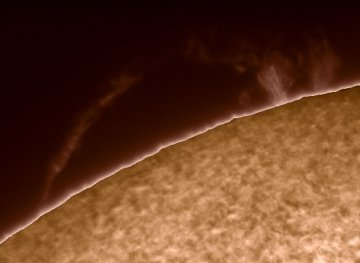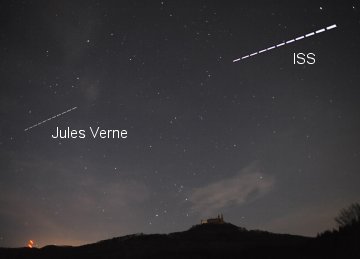| Where's Saturn? Is that a UFO--or the ISS? What's the name of that star? Get the answers from mySKY--a fun new astronomy helper from Meade. | |  | NAKED-EYE GAMMA RAY BURST: On March 19th, astronomers witnessed a cosmic explosion so bright it was visible to the naked eye from a distance of 7.5 billion light years. Get the full story from Science@NASA. SOLAR ACTIVITY: "There is a huge prominence on the sun today and it looks like it could erupt at any minute," reports Paul Haese of Blackwood, South Australia. He took this picture using his Coronado SolarMax60: 
"Wow! What a great sight it was this morning," adds photographer P-M Hedén who saw the same loop hours later from Vallentuna, Sweden. "This is a BIG prominence." A 24-hour movie made by the SOHO spacecraft confirms that this is a very dynamic prominence which could indeed collapse or erupt at any time. Readers, if you have a solar telescope, train it on the sun and prepare for action. more images: from Eric Roel of Valle de Bravo, Estado de México; from Jeff Barton of Dallas, Texas; from Pete Lawrence of Selsey, West Sussex, UK; from J. Fairfull and J. Stetson of South Portland, Maine; JULES VERNE AND THE ISS: "Now that the European Space Agency's Jules Verne cargo carrier is parked 2000 km in front of the International Space Station, observers have a good opportunity to see both spacecraft in the evening sky," says amateur astronomer Till Credner. On March 19th he photographed the pair streaking over Hohenzollern Castle in southern Germany: 
Click to play a 2.5 MB movie
"The Jules Verne appears about four and a half minutes before the ISS and they follow the same track across the sky," he says. "Jules Verne vanishes in the east just as the ISS appears in the west." These double-flybys will continue for at least another week. Jules Verne won't dock with the ISS (merging the two points of light) until after space shuttle Endeavour leaves the station on March 25th. Get your flyby alerts from Spaceweather PHONE. more images: from Robert Jeffers of Virginia Beach, VA; from Nikolas Gull of Herndon, VA; NEW--SIMPLE FLYBYS: Spaceweather.com has a new tool for US and Canadian readers: Simple Satellite Flybys. Just enter your zip code and it tells you about satellites due to fly over your area in the nights ahead. There are hundreds of spacecraft in Earth orbit; we cut through the confusion by narrowing the list to a half-dozen or so of the most interesting. At the moment we're monitoring Jules Verne, the International Space Station, space shuttle Endeavour and the Hubble Space Telescope. Please try it and, remember, it's a new tool with room for improvement. Feedback is welcomed. | 
